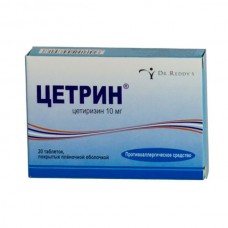Expiration date: 04/2026
The composition and form of issue:
Tablets, film-coated. 1 tablet contains:
cetirizine dihydrochloride 10 mg
excipients: lactose maize starch povidone (K-30) magnesium stearate hypromellose macrogol 6000 titanium dioxide talc sorbic acid Polysorbate 80 Dimethicone
blistere in 10 PCs in the paper cartons 2 blister.
Description pharmaceutical form:
Tablets: round, biconvex, film-coated, white or almost white, scored on one side.
Syrup: clear colorless or slightly yellowish, transparent liquid with pleasant fruit odour, free from visible particles. Little opalescence is allowed.
Pharmacokinetics:
Rapidly absorbed from the gastrointestinal tract, the time to maximum concentration (TCmax) after ingestion of about 1 h. the Bioavailability of cetirizine when used in the form of tablets and syrup are the same. Food does not affect the completeness of absorption (AUC), but lengthens for 1 h TCmax value and decreases Cmax by 23%. When taken in a dose of 10 mg 1 time per day during 10 days, steady-state drug concentration (Css) in plasma is 310 ng/ml and observed after 0.5–1.5 h after administration. The plasma protein binding is 93% and does not change when the concentration of cetirizine in the range of 25-1000 ng/ml. Pharmacokinetic parameters of cetirizine vary linearly with the dose of 5-60 mg. the Volume of distribution is 0.5 l/kg.
In small quantities metabolised in the liver by O-dezalkilirovania with the formation of pharmacologically inactive metabolite (unlike other blockers H1-histamine receptors, metabolized in the liver involving cytochrome P450). Cetirizine does not cumulates. About 2/3 of the drug is excreted unchanged by the kidneys and about 10% — with feces.
Systemic clearance of 53 ml/min. T1/2 adults — 10 hours (tablet) and 7-10 hours (syrup) in children of 6-12 years — 6 hours, 2-6 years — 5 h 0.5–2 years to 3.1 h in elderly patients T1/2 increased by 50%, systemic clearance is reduced by 40% (loss of kidney function).
In patients with impaired renal function (Cl creatinine <40 ml/min) clearance of the drug decreases and T1/2 longer (for example, patients on hemodialysis, the total clearance is reduced by 70% and is 0.3 ml/min/kg and T1/2 longer 3 times) that requires a corresponding change of dosing regimen. Almost is not removed during hemodialysis.
In patients with chronic liver diseases (hepatocellular, cholestatic or biliary cirrhosis of the liver) marked prolongation of T 1/2 of 50% and a decrease in the total clearance by 40% (the correction mode is required only if it is accompanied by decrease in glomerular filtration rate).
Passes into breast milk.
Description pharmacological action:
Competitive antagonist of histamine, a metabolite gidroxizina, blocks H1-histamine receptors. Warn development and facilitates the allergic reactions, has antipruritic and protivoekssoudative action. Affects early stage of allergic reactions, restricts the release of mediators of inflammation on the "late" stage allergic reactions, reduces migration of eosinophils, neutrophils and basophils. Reduces the permeability of capillaries, prevents the development of tissue edema, relieves spasms of smooth muscles.
Eliminates skin reaction to the introduction of histamine, specific allergens, as well as cooling (in cold urticaria). Reduces gistaminopodobnoe bronchoconstriction bronchial asthma lung flow.
Also has anticholinergic and antiserotonin action.
In therapeutic doses practically does not cause sedation. Beginning of effect after a single ingestion of 10 mg cetirizine — 20 min (50% of patients) and 60 min (in 95% of patients), continues for more than 24 hours On the background of the course of treatment, tolerance to the antihistaminic action of cetirizine does not develop. After discontinuation of the treatment effect persisted up to 3 days.
Indications:
- seasonal and perennial allergic rhinitis
- allergic conjunctivitis
- pollinosis (hay fever)
- urticaria, incl. chronic idiopathic urticaria
- itchy allergic dermatoses (atopic dermatitis, neurodermitis)
- angioedema (angioedema).
Syrup optional: atopic bronchial asthma (composed of combination therapy).
Contraindications:
- hypersensitivity (including to hydroxizine)
- pregnancy
- lactation
- children up to age 6 years (for tablets only)
- children up to age 2 years (for the syrup).
With caution:
- chronic renal failure (moderate and severe severity — requires correction mode)
- old age (may decrease glomerular filtration).
Application of pregnancy and breast-feeding:
Contraindicated in pregnancy. At the time of treatment should stop breastfeeding.
Side effects:
Helps usually well tolerated.
In some cases, drowsiness, dry mouth, rarely — headache, dizziness, migraine, discomfort in the gastrointestinal tract, allergic reactions (angioedema, rash, urticaria, itching).
Drug interactions:
Pharmacokinetic interactions with pseudoephedrine, cimetidine, ketoconazole, erythromycin, azithromycin, glipizide and diazepam was not detected.
Joint appointment with theophylline (400 mg/day) leads to a decrease in total clearance of cetirizine (kinetics of theophylline is not changed).
Mielotoksicskie HP increase symptoms gematotoksichnosti drug.
Method of application and dose:
Inside, regardless of meals, without chewing, drinking 200 ml of water.
Adults: 10 mg (1 table.) 1 times daily or 5 mg (1/2 table.) 2 times a day.
Children over 6 years: 5 mg (1/2 table.) 2 times a day, or 10 mg (1 table.) 1 time a day.
In patients with reduced renal function (Cl creatinine 30-49 ml/min) administered 5 mg/day (1/2 tab.), in severe chronic renal failure (Cl creatinine 10-30 ml/min) — 5 mg (1/2 table.) through the day.
Overdose:
Symptoms (occur in single dose at a dose of 50 mg): dry mouth, drowsiness, urinary retention, constipation, anxiety, irritability.
Treatment: washing stomach, the appointment of symptomatic drugs. There is no specific antidote. Hemodialysis is ineffective.
Special instructions:
When the dose 10 mg/day the ability to make quick reactions may deteriorate.
In recommended doses, increases the effects of ethanol (at concentrations of 0.8 g/l), however, it is recommended to refrain from the use of ethanol during treatment.
During the period of treatment must be careful when driving and occupation of other potentially hazardous activities, require high concentration and psychomotor speed reactions.
For the child's age (2 years) Cethrin is applied in the form of syrup.



